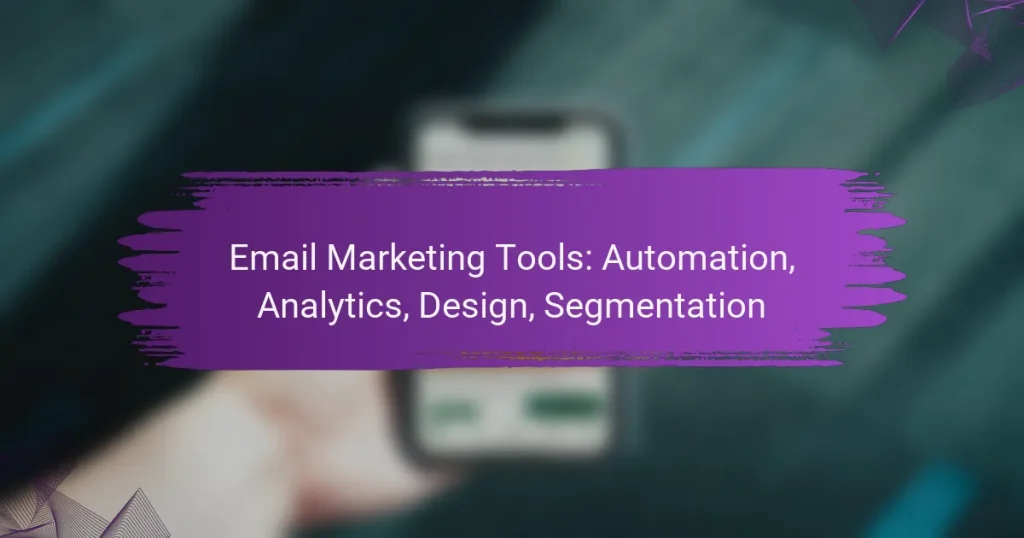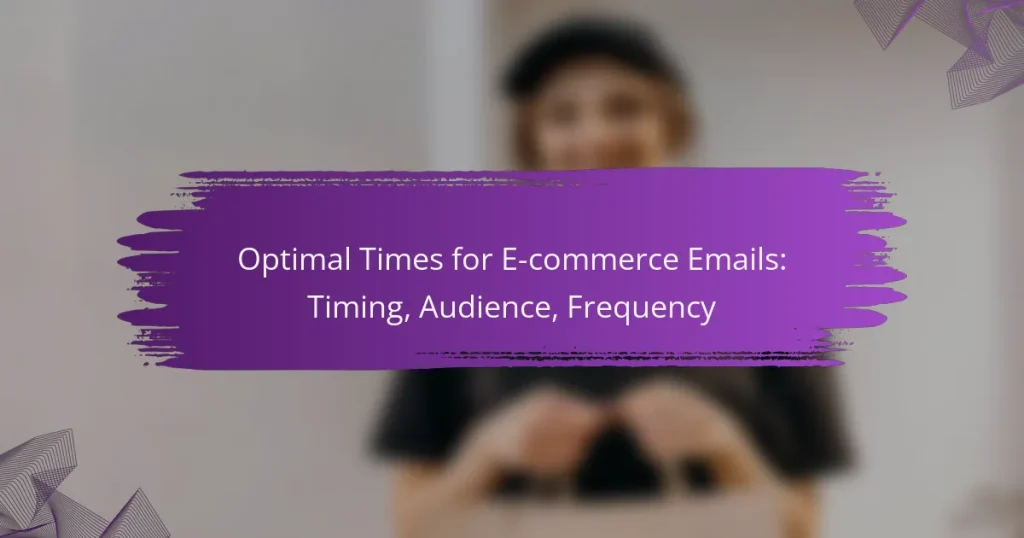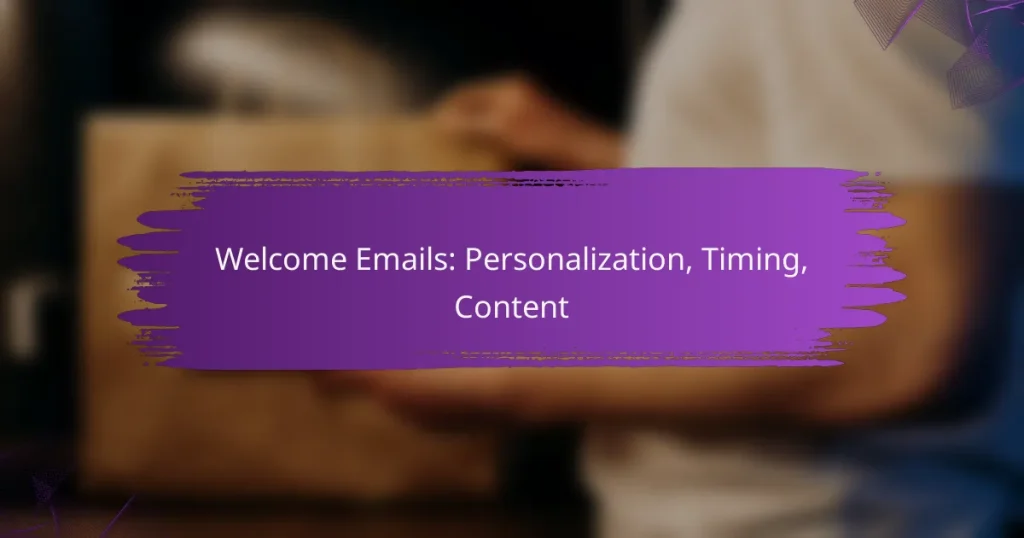Email marketing is a powerful tool for e-commerce businesses, enabling them to enhance customer engagement and boost sales through targeted strategies. By utilizing personalization, segmentation, and automation, marketers can craft compelling campaigns that resonate with their audience. Optimizing send times and ensuring mobile-friendly designs further improve open rates and engagement, ultimately leading to greater success in driving conversions.
Optimal Times for E-commerce Emails: Timing, Audience, Frequency
Email Segmentation Strategies: Demographics, Behavior, Preferences
Welcome Emails: Personalization, Timing, Content
Personalization Techniques: Dynamic Content, Recommendations and Timing
What are effective email marketing tactics for e-commerce?
Effective email marketing tactics for e-commerce include strategies that enhance customer engagement and drive sales. These tactics leverage personalization, segmentation, automation, and compelling content to create impactful email campaigns.
Personalization strategies
Personalization in email marketing involves tailoring content to individual customer preferences and behaviors. This can include using the recipient’s name, recommending products based on past purchases, or sending targeted offers. Implementing personalized emails can significantly increase open rates and conversions.
To maximize effectiveness, utilize customer data from previous interactions and purchase history. For instance, if a customer frequently buys athletic gear, send them promotions on related products or new arrivals in that category.
Segmentation techniques
Segmentation involves dividing your email list into smaller groups based on specific criteria such as demographics, purchase behavior, or engagement levels. This allows for more targeted messaging that resonates with each group. For example, you might segment customers into categories like frequent buyers, first-time buyers, or those who have abandoned their carts.
Effective segmentation can lead to higher engagement rates. Consider using tools that allow you to analyze customer behavior and create segments accordingly. Regularly update your segments to reflect changes in customer behavior and preferences.
Automated email campaigns
Automated email campaigns are pre-scheduled emails that are sent based on specific triggers, such as a customer signing up for a newsletter or abandoning a shopping cart. These campaigns save time and ensure timely communication with customers. Common types of automated emails include welcome emails, cart abandonment reminders, and post-purchase follow-ups.
To implement automation effectively, choose an email marketing platform that supports automation workflows. Monitor the performance of these campaigns to optimize timing and content based on customer responses.
Engaging subject lines
Engaging subject lines are crucial for improving open rates. They should be concise, clear, and create a sense of urgency or curiosity. A well-crafted subject line can make the difference between an email being opened or ignored.
Consider using action-oriented language and personalization in your subject lines. For example, “John, your exclusive 20% off awaits!” can be more enticing than a generic discount email. Test different styles to see what resonates best with your audience.
A/B testing methods
A/B testing involves comparing two versions of an email to determine which performs better. This can include variations in subject lines, content, images, or call-to-action buttons. By systematically testing different elements, you can refine your email marketing strategy based on data-driven insights.
Start with one variable at a time to clearly identify what influences performance. For example, test two different subject lines for the same email and analyze the open rates. Use the results to inform future campaigns and continuously improve your email marketing efforts.
How can e-commerce businesses improve open rates?
E-commerce businesses can improve email open rates by optimizing their send times, crafting compelling preview text, and ensuring mobile-friendly designs. These strategies enhance engagement and encourage recipients to open emails, ultimately driving sales.
Optimal send times
Choosing the right send time is crucial for maximizing open rates. Research indicates that emails sent on weekdays, particularly Tuesday to Thursday, often see higher engagement compared to weekends. Additionally, consider the time of day; early mornings or late afternoons typically yield better results as people check their emails before starting work or after hours.
Testing different send times can help identify when your specific audience is most responsive. Utilize A/B testing to compare open rates across various days and times to refine your strategy.
Compelling preview text
Preview text is the snippet that appears next to or below the subject line in an inbox, making it essential for capturing attention. Crafting engaging preview text can significantly influence whether recipients decide to open your email. Aim for concise, intriguing messages that complement the subject line and provide a clear value proposition.
For example, instead of a generic preview like “Spring Sale,” try “Exclusive 20% off your favorite spring styles!” This not only informs but also entices the reader to open the email for more details.
Mobile-friendly designs
With a significant portion of emails being opened on mobile devices, ensuring your email design is mobile-friendly is vital. Use responsive design techniques that adapt to various screen sizes, ensuring text is readable and images are appropriately sized. A clean layout with clear calls to action enhances user experience on mobile.
Additionally, keep your email content concise. Mobile users appreciate quick, digestible information, so avoid lengthy paragraphs and focus on key messages. Test your emails on multiple devices to ensure consistent appearance and functionality.
What metrics should e-commerce marketers track?
E-commerce marketers should focus on key metrics that provide insights into the effectiveness of their email marketing campaigns. Tracking open rates, click-through rates, and conversion rates helps marketers understand audience engagement and overall campaign performance.
Open rates
Open rates indicate the percentage of recipients who opened an email. A typical open rate for e-commerce emails ranges from 15% to 25%, but this can vary based on industry and audience. To improve open rates, consider crafting compelling subject lines and optimizing send times.
Monitoring open rates helps identify trends over time. If rates drop significantly, it may signal issues with your subject lines or list quality. Regularly cleaning your email list can also enhance engagement.
Click-through rates
Click-through rates (CTR) measure the percentage of recipients who clicked on links within an email. A good CTR for e-commerce emails typically falls between 2% and 5%. To boost CTR, ensure that your email content is relevant and includes clear calls to action.
Analyzing CTR can reveal which products or offers resonate most with your audience. A/B testing different layouts or content can help determine what drives higher engagement and clicks.
Conversion rates
Conversion rates reflect the percentage of email recipients who completed a desired action, such as making a purchase. For e-commerce, a conversion rate of 1% to 3% is common, but this can vary based on factors like the quality of the email list and the effectiveness of the offer.
To enhance conversion rates, focus on personalized content and targeted promotions. Segmenting your audience based on past behavior can lead to more relevant offers, increasing the likelihood of conversions.
What are the best email marketing platforms for e-commerce?
The best email marketing platforms for e-commerce include Mailchimp, Klaviyo, and Constant Contact. These platforms offer a range of features tailored to help online businesses effectively engage with their customers and drive sales.
Mailchimp features
Mailchimp is known for its user-friendly interface and robust automation capabilities. It offers customizable email templates, audience segmentation, and detailed analytics to track campaign performance.
Additionally, Mailchimp integrates with various e-commerce platforms, allowing for seamless data synchronization. Users can create targeted campaigns based on customer behavior, which can significantly enhance engagement rates.
Klaviyo benefits
Klaviyo excels in advanced segmentation and personalization, making it a top choice for e-commerce businesses. It allows users to create highly targeted email campaigns based on customer data and purchase history.
With its powerful automation features, Klaviyo can send timely messages triggered by specific actions, such as cart abandonment or product recommendations. This capability often leads to higher conversion rates and increased customer loyalty.
Constant Contact advantages
Constant Contact offers a comprehensive suite of tools designed for small to medium-sized e-commerce businesses. Its features include easy-to-use email builders, social media integration, and event marketing capabilities.
The platform also provides excellent customer support and resources for users new to email marketing. Constant Contact’s straightforward pricing model makes it accessible for businesses looking to enhance their email marketing efforts without significant upfront investment.
How to create a successful email marketing strategy?
To create a successful email marketing strategy, focus on understanding your audience and crafting targeted messages that resonate with them. This involves segmenting your email list, personalizing content, and analyzing performance metrics to refine your approach.
Define your target audience
Identifying your target audience is crucial for effective email marketing. Start by analyzing demographics, interests, and purchasing behavior to create detailed buyer personas. This allows you to tailor your messages and offers to meet the specific needs of different segments.
Build a quality email list
A quality email list is foundational to your email marketing success. Use opt-in forms on your website, social media, and during checkout to encourage sign-ups. Ensure that you comply with regulations like GDPR or CAN-SPAM by obtaining explicit consent and providing clear unsubscribe options.
Create engaging content
Engaging content is key to capturing your audience’s attention. Use compelling subject lines, personalized greetings, and relevant offers to entice recipients to open and read your emails. Incorporate visuals and concise text to enhance readability and keep your messages focused.
Optimize for mobile
With a significant portion of emails opened on mobile devices, optimizing your emails for mobile viewing is essential. Use responsive design to ensure your emails display correctly on various screen sizes. Keep your layout simple, and use larger fonts and buttons for easy navigation.
Analyze and adjust
Regularly analyzing your email marketing performance helps you understand what works and what doesn’t. Track metrics such as open rates, click-through rates, and conversions to gauge effectiveness. Use A/B testing to experiment with different subject lines, content, and send times to continuously improve your strategy.




